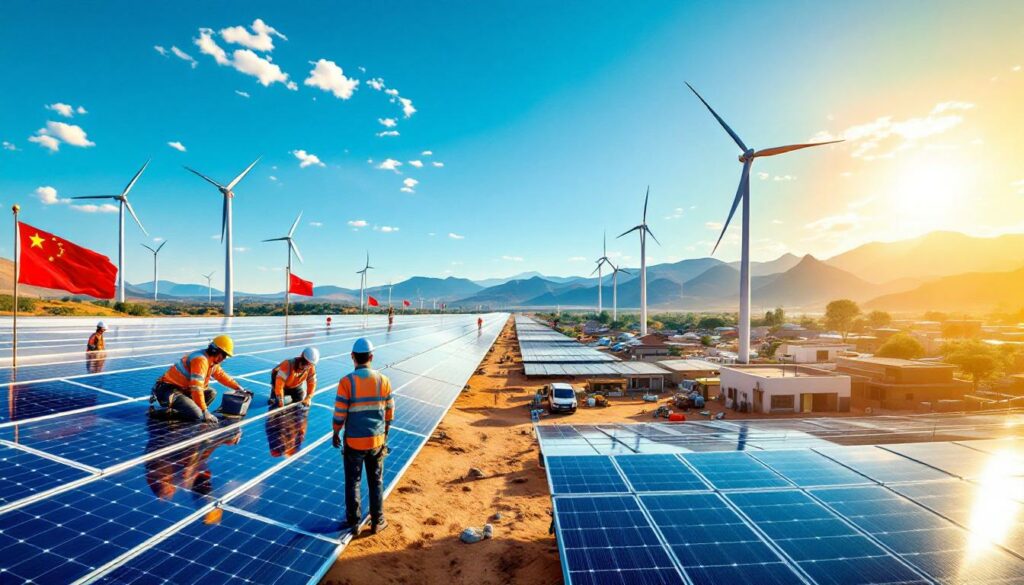China's Strategic Approach to Clean Energy Partnerships in Africa
China's engagement with Africa on clean energy represents a transformative shift in international relations, combining economic strategy with sustainable development goals. This partnership, evident across solar, wind, and electric vehicle sectors, illustrates how China's regional approaches like the Hunan model are reshaping energy landscapes throughout the African continent.
The collaboration between China and Africa in clean energy stems from China's dual objectives: securing critical minerals for energy transition while reducing dependency on traditional oil and gas imports. As Martin Creamer of Mining Weekly noted in June 2025: "China doesn't want to be committed to having to import oil and gas. It wants to generate clean, green energy from the sun and wind."
This strategic pivot manifests through targeted investments, knowledge transfer initiatives, and manufacturing partnerships that span multiple African nations.
How is China Engaging with Africa on Clean Energy Initiatives?
China's approach to clean energy collaboration in Africa represents a carefully orchestrated diplomatic and economic strategy, with particular focus on countries with historical liberation movements. According to Mining Weekly's 2025 reporting, "China is going all out to collaborate with liberation movement countries like South Africa," establishing a pattern of engagement that combines industrial presence with educational investment.
The partnership model emphasizes mutual benefits: African nations gain access to renewable technologies and skills development, while China secures critical mineral resources and expands markets for its clean energy products.
The Hunan Model: A Framework for Collaboration
The Hunan provincial model exemplifies China's strategic approach to African engagement. This framework leverages Hunan's own transition from agricultural dependency to green manufacturing as a blueprint for African development.
Key components of this model include:
- Establishing regional operational hubs in strategic locations (e.g., Sany's industrial equipment base on Gauteng's East Rand serving Southern Africa)
- Creating manufacturing facilities that adapt Chinese technologies to African conditions
- Developing educational partnerships like Technical and Vocational Education and Training (TVET) colleges in Tanzania specifically focused on green energy skills
- Implementing solar and wind solutions aligned with local conditions and needs
The model represents a shift from extractive relationships toward collaborative capacity building, though questions remain about long-term sustainability and equity.
Strategic Motivations Behind China's African Engagement
China's accelerating investment in African clean energy stems from several converging factors:
- Economic diversification: The partnership represents a strategic hedge against trade tensions with Western markets, creating alternative revenue streams for Chinese manufacturers
- Resource security: Access to Africa's critical minerals for energy transition essential for renewable technologies
- Market expansion: Africa's rapidly growing population and energy demand present significant opportunities for Chinese renewable technology companies
- Diplomatic influence: Clean energy collaboration builds strategic relationships with resource-rich nations through development partnerships
As noted at the 2025 London Indaba (reported by Mining Weekly), China "sees pleasing Africa as a form of insurance against trade wars," indicating the geopolitical dimensions of these ostensibly commercial relationships.
What Clean Energy Technologies is China Bringing to Africa?
Chinese companies are deploying a diverse range of renewable technologies across Africa, from utility-scale installations to distributed systems for rural electrification. Mining Weekly's 2025 reporting highlighted the ubiquity of Chinese solar technology: "You just see solar panels everywhere."
These deployments focus on technologies that China has mastered domestically while adapting them to African environmental conditions and infrastructure constraints.
Solar Power Development and Manufacturing
China dominates Africa's solar landscape through:
- Utility-scale solar farms ranging from 50MW (like Kenya's Garissa project) to 300MW+ installations
- Manufacturing and assembly facilities that employ local workers while maintaining Chinese technical standards
- Solar home systems bringing electricity to off-grid communities through innovative payment models
- Adaptation of solar technologies to withstand African climate conditions (high temperatures, dust, humidity)
The widespread deployment of Chinese solar technology throughout Africa reflects both commercial strategy and energy access objectives, with particular focus on regions with high solar potential like East Africa and the Sahel.
Wind Energy Projects and Knowledge Transfer
Chinese wind energy projects in Africa focus on:
- Coastal and highland regions with optimal wind resources (e.g., Lake Turkana in Kenya, Morocco's Atlantic coast)
- Transfer of maintenance expertise through training programs for local technicians
- Grid integration solutions addressing the intermittent nature of wind generation
- Hybridized wind-solar installations to optimize renewable generation profiles
Chinese wind technology manufacturers like Goldwind and Mingyang have established significant presence in the African market, often through partnerships with local development agencies.
Electric Vehicle and Green Transportation Initiatives
BYD's expansion from its Hunan base into African markets signals China's commitment to electrifying African transportation:
- Electric bus fleets for urban public transportation in major African cities
- Charging infrastructure deployment, often powered by Chinese-manufactured solar systems
- Two and three-wheeled electric vehicles adapted for African urban conditions
- Manufacturing facilities creating jobs while reducing import dependencies
As Mining Weekly reported in 2025, BYD's presence in South Africa serves as a springboard for broader expansion throughout Southern Africa, creating an integrated approach to electric vehicles transforming mining and transportation sectors.
How Are Educational Partnerships Advancing Clean Energy Skills?
The skills transfer component of China-Africa clean energy collaboration represents perhaps its most sustainable long-term impact. Rather than simply exporting technology, Chinese initiatives increasingly focus on building local capacity.
Technical Training Centers and TVET Colleges
China's educational investments in Africa's renewable energy sector focus on practical skills development:
- TVET colleges in Tanzania specifically designed for "educating Africa into the new green energy transition" (Mining Weekly, 2025)
- Hands-on training programs for solar installation, maintenance, and troubleshooting
- Curriculum development incorporating both Chinese technological standards and African contextual realities
- Certification programs aligned with international renewable energy standards
These educational initiatives address Africa's critical skills gap in renewable energy while creating pathways for further Chinese technological deployment.
Research Collaboration and Technology Adaptation
Beyond vocational training, China is fostering deeper research partnerships:
- Joint research initiatives between Chinese renewable energy institutes and African universities
- Collaborative development of solar and wind technologies optimized for African environmental conditions
- Innovation in off-grid systems particularly suited to rural African contexts
- Knowledge transfer on grid integration and energy storage solutions
These research collaborations enable African institutions to participate in technology development rather than remaining passive recipients of Chinese innovations.
What Benefits Does Africa Gain from Chinese Clean Energy Investment?
The China-Africa clean energy partnership delivers multiple benefits to participating African nations, though outcomes vary significantly across different countries and project types.
Energy Access Expansion and Rural Electrification
Chinese renewable deployments are accelerating energy access across Africa:
- Off-grid solar systems bringing first-time electricity to remote communities
- Mini-grid deployments providing more reliable power than traditional diesel generators
- Utility-scale projects boosting national generation capacity
- Specialized applications like solar water pumping and agricultural processing
These initiatives directly support Sustainable Development Goal 7 (affordable, reliable, sustainable energy) while demonstrating the viability of renewable solutions in challenging contexts.
Economic Development and Job Creation
The economic impacts extend beyond energy access:
- Manufacturing jobs in assembly facilities for solar panels and components
- Technical positions maintaining renewable installations
- Supply chain opportunities for local businesses providing materials and services
- Construction employment during project development phases
While precise employment figures require validation, the scale of Chinese renewable investments suggests significant job creation potential, particularly in technical roles that offer higher wages and skill development.
Technology Transfer and Local Capacity Building
The long-term value of China's engagement lies in knowledge transfer:
- Technical expertise development through TVET programs and on-site training
- Management capacity for large-scale renewable energy infrastructure
- Business model innovation for clean energy deployment and financing
- Manufacturing know-how through joint venture arrangements
The excitement reported at the 2025 London Indaba around Chinese TVET initiatives highlights the potential for genuine skills transfer that enables African ownership of renewable energy transitions.
What Challenges Exist in China-Africa Clean Energy Collaboration?
Despite promising aspects, several challenges must be addressed to ensure sustainable and equitable outcomes from China-Africa clean energy partnerships.
Financing Models and Debt Sustainability
Financial structures require careful consideration:
- Risk of unsustainable debt from large infrastructure investments
- Need for transparent financing terms that balance commercial and development objectives
- Concerns about collateralization of natural resources for project financing
- Challenges in ensuring projects remain economically viable throughout their operational lifespans
Without addressing these financial concerns, renewable energy projects risk replicating problematic aspects of previous resource-extraction relationships.
Environmental and Social Impact Considerations
Renewable energy, while cleaner than fossil alternatives, still presents environmental challenges:
- Land use conflicts from large-scale solar and wind installations
- Community displacement concerns, particularly in areas with unclear land rights
- End-of-life waste management for solar panels and batteries containing hazardous materials
- Water usage concerns for panel cleaning in water-scarce regions
Comprehensive environmental and social impact assessments are essential to ensure that clean energy projects deliver net positive outcomes for local communities.
Technology Appropriateness and Maintenance Challenges
Sustainability depends on technological suitability:
- Adaptation requirements for technologies facing African climate extremes
- Spare parts availability and technical support accessibility
- Local maintenance capacity development for long-term operation
- Grid integration challenges for intermittent renewable generation
Addressing these technical challenges requires deeper collaboration between Chinese manufacturers and African utilities and maintenance providers.
How Does the Collaboration Support Africa's Energy Transition Goals?
China-Africa clean energy partnerships align with broader continental objectives for sustainable mining transformation and climate action, though integration with national policies varies significantly.
Contribution to National Renewable Energy Targets
Many collaborative projects directly support policy objectives:
- Accelerating progress toward Nationally Determined Contributions under the Paris Agreement
- Supporting renewable capacity targets in national energy plans
- Demonstrating the commercial viability of renewable alternatives to fossil generation
- Creating implementation pathways for ambitious policy commitments
The Richards Bay Minerals (RBM) example highlighted by Mining Weekly demonstrates how renewable energy can rapidly scale in industrial settings, with power purchase agreements for solar and wind enabling 80% renewable electricity by 2027 through South Africa's wheeling system.
Climate Resilience and Adaptation Benefits
Beyond emissions reduction, these initiatives support climate adaptation:
- Decentralized energy systems less vulnerable to climate impacts than centralized infrastructure
- Reduced dependency on hydropower in drought-vulnerable regions
- Energy infrastructure designed with changing climate conditions in mind
- Diversified generation providing greater system resilience
As climate impacts intensify across Africa, the resilience benefits of distributed renewable systems become increasingly valuable. Furthermore, these systems contribute to broader decarbonisation in mining and industrial sectors.
What Future Trends Will Shape China-Africa Clean Energy Relations?
The evolving landscape of global energy transitions and geopolitical dynamics will influence the future direction of these partnerships.
Emerging Technology Focus Areas
Several technology domains are gaining prominence:
- Energy storage solutions addressing intermittency challenges
- Green hydrogen production leveraging abundant renewable resources
- Smart grid technologies optimizing distribution efficiency
- Digital solutions for system management and maintenance
The relationship between renewable energy and critical minerals extraction represents another crucial trend, with Mining Weekly reporting in 2025 that "there is a whole new surge in mining industry evolution" tied to the energy transition.
Evolving Investment and Partnership Models
Financial structures are also evolving:
- Shift toward more equitable risk-sharing arrangements
- Greater involvement of African financial institutions
- Emphasis on technology transfer and local manufacturing
- Development of regional projects spanning multiple countries
The Malawi example cited by Mining Weekly, which opened its geological survey data to attract investment, indicates how African nations are becoming more strategic in managing relationships with Chinese partners.
Integration with Broader Development Initiatives
Clean energy collaboration increasingly connects to wider development programs:
- Alignment with the African Continental Free Trade Area
- Integration with industrial and agricultural modernization
- Support for digital infrastructure through reliable power
- Coordination with transportation electrification initiatives
This holistic approach recognizes that energy transitions must be embedded within broader sustainable development strategies to deliver maximum benefits, as highlighted in the 2024 FOCAC Summit declaration on China-Africa cooperation.
FAQ: China-Africa Clean Energy Collaboration
What specific renewable energy projects has China developed in Africa?
China has implemented numerous renewable energy projects across Africa, including the 50 MW Garissa solar plant in Kenya, the 300 MW De Aar wind farm in South Africa, and multiple hydropower projects in countries like Ethiopia and Zambia. These installations range from utility-scale developments to distributed systems for rural electrification.
How does China's approach to African energy differ from Western countries?
China's approach typically emphasizes infrastructure development, technology transfer, and skills training without political conditionality. This contrasts with some Western approaches that may include governance requirements. Chinese engagement often features more state-backed financing and focuses on turnkey project delivery, though this model is evolving toward more collaborative partnerships.
What role do Chinese companies play in Africa's solar industry?
Chinese companies are involved throughout Africa's solar value chain, from manufacturing and assembly to installation and maintenance. Major players include Jinko Solar, JA Solar, and companies like Sany that provide components, technical expertise, and sometimes financing for projects ranging from utility-scale solar farms to small off-grid systems.
How are African countries building local capacity through these partnerships?
Many collaborative projects include skills development components such as technical training programs, knowledge transfer initiatives, and educational partnerships. As reported by Mining Weekly in 2025, China has established dedicated renewable energy training centers in Tanzania, while other countries have incorporated technical exchange programs that bring African technicians to China for specialized training, as noted in WRI's analysis of trilateral cooperation in the clean energy sector.
Disclaimer: This article contains analysis of current trends and projects in China-Africa clean energy collaboration. Future developments may differ from projections. Financial and investment information should not be considered as advice. Readers should consult appropriate professionals before making investment decisions related to clean energy projects.
Want to Capitalise on the Next Major ASX Mineral Discovery?
Stay ahead of the market with Discovery Alert's proprietary Discovery IQ model, which delivers instant notifications on significant mineral discoveries across 30+ commodities on the ASX. Visit the discoveries page to see how historic discoveries have generated substantial returns for early investors.




